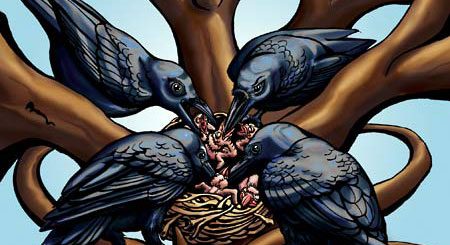The Young and the Restless: Watching Neighborhood Crows
By Andrea Townsend; Illustration by Carly Hodes
January 15, 2010
Watching your neighborhood crows
People often complain about noisy crows waking them up in the morning—usually an extended family of crows starting their day. American Crows are the most widespread cooperatively breeding species in North America. A family unit usually includes a mom and dad and several “kids” hatched in previous years, and can include up to 15 birds! They include goofy, immature one-year-olds and some adult sons and daughters. Sometimes these kids stay with their parents for more than five years. In addition to the nuclear family, crow groups sometimes include extended family members such as nephews, brothers, and half-brothers of the mom and dad. We’ve also seen crows “adopt” the kids of unrelated neighbors.
Once you recognize your local family groups, it’s fun watching the kids play with each other and learn from older birds. You might see family feuds and fights, wars with neighbors, and the courtship of older birds. If you regularly offer food scraps near your bird feeder, your local crow family might start spending part of its day right where you can see it. The following are some behaviors to look out for, throughout the seasons.
March and April: Crows are courting and building nests. The breeding “mom” and “dad,” who usually stay together as a pair throughout the year, are two of the blackest, glossiest birds in their group. In the early breeding period, they tend to stay very close to each other, the dad following the mom’s every move, flying after her when she flies, and alighting next to her on her branch. If another male lands near her, the dad will fly over and swoop down, inserting himself between them. Family fighting and strife is highest during this season, particularly when other adult males are interested in courting the mom.
This is also a good time to identify the one-year-olds. Unlike adults, yearlings usually are dull brownish instead of glossy. Their feathers look so ragged you might wonder how they can fly.
Early in the season, watch for crows carrying sticks. You can often follow them to their nest tree, which is usually close to the top of a tall conifer. You’ll know when they’re close to finishing a nest if you see them carrying soft lining material, like dog or deer hair. In many areas, crows start nest building as snow begins to melt. Females might get doused in a few late snowstorms while sitting on their nests.
April: Tune into a new, high-pitched crow sound that we call “whining.” The mom makes this sound when she is sitting on the nest. Dad and the “helpers” often fly to her with food. After the eggs hatch, Dad and the helpers also bring food to the nestlings. Mom is the only bird who incubates the eggs and broods the nestlings.
June and July: This is often the noisiest time of year for crows. The fledglings are leaving the nest, although they stay in trees and don’t stray far at first. They make clamorous “begging” calls to their parents and older helpers. After a few weeks, the fledglings will follow their parents, begging, on the ground. You can sometimes see the harried-looking parents turn to stuff some food (a worm, chunks of roadkill, bread crusts, etc.) into their big mouths. Notice that the young birds’ mouths are red inside. This will change to black as they mature.
Juvenile birds spend a lot of time playing. You might see them wrestling or pulling each other’s tails.
September: In early fall, many crows start leaving their territories to forage in other places. They can congregate in cornfields, the town dump, or wooded areas rich with acorns, beechnuts, and other mast. Watch especially for juvenile gangs: big groups of new fledglings and yearlings gathering at a neighborhood food source. This is also the time of year when baby crows start practicing their repertoire. You might notice one sitting alone on a branch, stringing together all sorts of funny sounds.
Winter: During the winter months in many latitudes, people are amazed to see huge flocks of crows gathering on golf courses, fields, dumps, and other places. These flocks include birds from farther north spending the winter, and also local residents. Most resident family groups spend at least part of every day on their home territories, but spend time with the big flocks and roosts, too. The antics of the crows in these flocks make this a very noisy but fun experience for crow-watchers. If you happen to see a crow with a wing tag in your flock, be sure to let the crow biologists at the Cornell Lab of Ornithology know! It might be one the crows that we tagged, and we always love to know where our birds end up. For more information, visit www.birds.cornell.edu/crows/crowinfo.htm.
Andrea Townsend is a postdoctoral fellow in the Fuller Evolutionary Biology Program at the Cornell Lab of Ornithology.
Originally published in the January 2010 issue of BirdScope.

All About Birds
is a free resource
Available for everyone,
funded by donors like you
American Kestrel by Blair Dudeck / Macaulay Library
